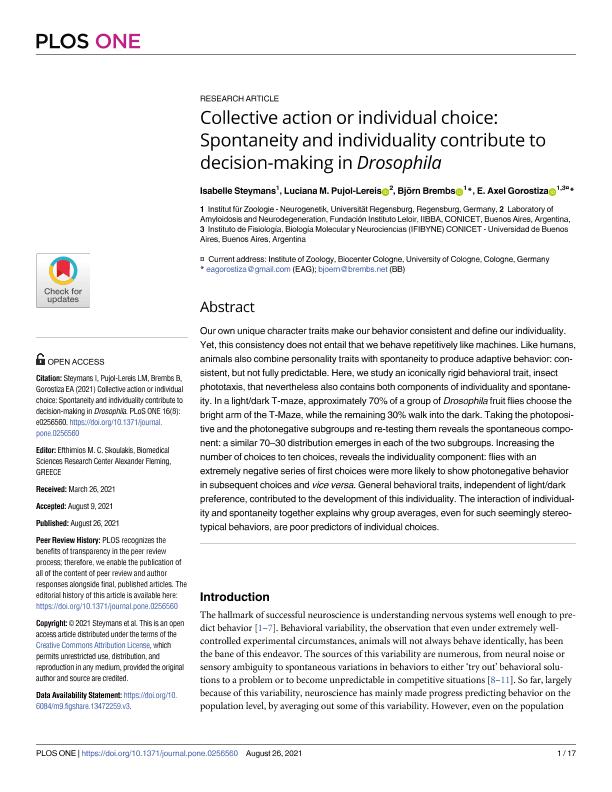Mostrar el registro sencillo del ítem
dc.contributor.author
Steymans, Isabelle
dc.contributor.author
Pujol Lereis, Luciana Mercedes

dc.contributor.author
Brembs, Björn
dc.contributor.author
Gorostiza, Ezequiel Axel

dc.date.available
2022-12-21T17:52:03Z
dc.date.issued
2021-08
dc.identifier.citation
Steymans, Isabelle; Pujol Lereis, Luciana Mercedes; Brembs, Björn; Gorostiza, Ezequiel Axel; Collective action or individual choice: Spontaneity and individuality contribute to decision-making in Drosophila; Public Library of Science; Plos One; 16; 8; 8-2021; 1-17; e0256560
dc.identifier.issn
1932-6203
dc.identifier.uri
http://hdl.handle.net/11336/182073
dc.description.abstract
Our own unique character traits make our behavior consistent and define our individuality. Yet, this consistency does not entail that we behave repetitively like machines. Like humans, animals also combine personality traits with spontaneity to produce adaptive behavior: consistent, but not fully predictable. Here, we study an iconically rigid behavioral trait, insect phototaxis, that nevertheless also contains both components of individuality and spontaneity. In a light/dark T-maze, approximately 70% of a group of Drosophila fruit flies choose the bright arm of the T-Maze, while the remaining 30% walk into the dark. Taking the photopositive and the photonegative subgroups and re-testing them reveals the spontaneous component: a similar 70–30 distribution emerges in each of the two subgroups. Increasing the number of choices to ten choices, reveals the individuality component: flies with an extremely negative series of first choices were more likely to show photonegative behavior in subsequent choices and vice versa. General behavioral traits, independent of light/dark preference, contributed to the development of this individuality. The interaction of individuality and spontaneity together explains why group averages, even for such seemingly stereotypical behaviors, are poor predictors of individual choices.
dc.format
application/pdf
dc.language.iso
eng
dc.publisher
Public Library of Science

dc.rights
info:eu-repo/semantics/openAccess
dc.rights.uri
https://creativecommons.org/licenses/by/2.5/ar/
dc.subject
DECISIONS
dc.subject
PHOTOTAXIS
dc.subject
BEHAVIOR
dc.subject
CHOICE
dc.subject.classification
Zoología, Ornitología, Entomología, Etología

dc.subject.classification
Ciencias Biológicas

dc.subject.classification
CIENCIAS NATURALES Y EXACTAS

dc.title
Collective action or individual choice: Spontaneity and individuality contribute to decision-making in Drosophila
dc.type
info:eu-repo/semantics/article
dc.type
info:ar-repo/semantics/artículo
dc.type
info:eu-repo/semantics/publishedVersion
dc.date.updated
2022-09-23T14:25:18Z
dc.journal.volume
16
dc.journal.number
8
dc.journal.pagination
1-17; e0256560
dc.journal.pais
Estados Unidos

dc.journal.ciudad
San Francisco
dc.description.fil
Fil: Steymans, Isabelle. Universitat Regensburg; Alemania
dc.description.fil
Fil: Pujol Lereis, Luciana Mercedes. Consejo Nacional de Investigaciones Científicas y Técnicas. Oficina de Coordinación Administrativa Parque Centenario. Instituto de Investigaciones Bioquímicas de Buenos Aires. Fundación Instituto Leloir. Instituto de Investigaciones Bioquímicas de Buenos Aires; Argentina
dc.description.fil
Fil: Brembs, Björn. Universitat Regensburg; Alemania
dc.description.fil
Fil: Gorostiza, Ezequiel Axel. Universitat Regensburg; Alemania. Consejo Nacional de Investigaciones Científicas y Técnicas. Oficina de Coordinación Administrativa Ciudad Universitaria. Instituto de Fisiología, Biología Molecular y Neurociencias. Universidad de Buenos Aires. Facultad de Ciencias Exactas y Naturales. Instituto de Fisiología, Biología Molecular y Neurociencias; Argentina
dc.journal.title
Plos One

dc.relation.alternativeid
info:eu-repo/semantics/altIdentifier/url/https://journals.plos.org/plosone/article?id=10.1371/journal.pone.0256560
dc.relation.alternativeid
info:eu-repo/semantics/altIdentifier/doi/http://dx.doi.org/10.1371/journal.pone.0256560
Archivos asociados
